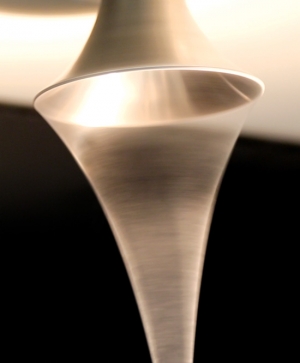Researchers put a new spin on nanofibre
Research news
Forget traditional spinning methods. These will have no place when it comes to spinning the world’s newest fibre – nanofibre. Thinner than a human hair, the next generation of these tiny fibres are set to be produced by groundbreaking new technology developed at Deakin University.
Researchers at Deakin’s Institute for Frontier Materials have designed three machines based on the electrospinning principle, which uses an electrical charge to create tiny fibres from a liquid.
The machines have just been installed at the Waurn Ponds campus - and two of them have been funded by the Australian National Fabrication Facility.
Along with cutting edge research, the investment cements Deakin’s status as a world leader in high tech fibre – and aims to take the technology out of the research lab and into the commercial arena.
Potential applications for the nanofibre include such mind-boggling products as high performance filters, bandages for wound healing, oil-water separation membranes, defence clothing, or even artificial blood vessels!
The unique properties of nanofibre – that stem from its high surface-to-volume ratio, permeability, light weight, strength and the breadth of materials from which it can be made – make it ideal for a myriad of uses that require water resistance, breathability, wind resistance, durability or one-way fluid transmission.
In fact, these characteristics make nanofibre the best filtration material in the world, collecting oil, dust or other pollutants from air or liquid.
Two of Deakin’s new machines produce nonwoven nanofibre, while the third electrospinner directly processes polymer solution into continuous nanofibre yarn – a world first – opening the way for a plethora of new applications.
Over the past decade, various university research labs have been exploring the use of a tiny nozzle to spray the web-like nanofibres onto a roller. A small number of manufacturers have been successfully producing nanofibre for air and water filtration using this technique.
According to world nanofibre expert, Professor Tong Lin, who is an ARC Future Fellow at Deakin, “the next generation of fibre will be nanofibre, and will be used - perhaps in combination with conventional fibre - in many other types of application, ranging from environmental protection, to biomedical, textiles and electronics areas.”
“We are working with companies such as Donaldson, a world leader in the filtration industry, to develop new applications,” he said.
Prof Lin and his colleagues are also refining nanofibre fabrics that are set to achieve a new level of sophistication. For example, the team has discovered that nonwoven nanofibre has an exceptional ability to convert mechanical energy into electric power - that would work as a fabric energy harvester.
They are also developing a nanofibre membrane with one-way transport for oil, yet is highly resistant to water. This innovation will be highly useful in advanced membrane materials for fuel recovery, environmental protection and industry uses.
In the biomedical sphere, nanofibre has the potential to be used in areas ranging from wound dressing, to tissue engineering and scaffolding, to knitting blood vessels. Its high permeability and potential biodegradability (it can be made from materials such as collagen or elastin) mean that it wouldn’t cause rejection or infection problems when used in the human body. A range of applications are currently being explored alongside biomedical researchers at Deakin.
“There are so many possibilities for nanofibre,” said Professor Lin. “Now that we have the nonwoven fibre and the yarn, the next stage will be working with innovators in industry to bring new applications to the public.”
Share this story
 Electrospinning uses an electrical charge to create tiny fibres from a liquid.
Electrospinning uses an electrical charge to create tiny fibres from a liquid.
